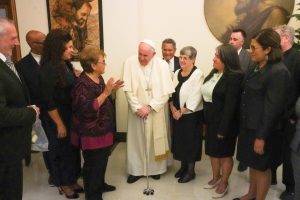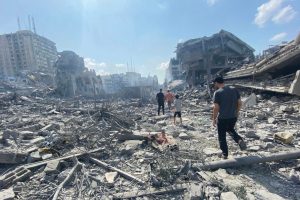MJ Park remembers, as a young Catholic, attending marches and rallies calling for fair housing, equal rights, and other social justice causes. Such causes were dear to her mother, who was greatly influenced by Martin Luther King Jr.’s fight for civil rights as a path toward peace. Park also remembers her father’s often-recited prayer: “Lord, make me an instrument of your peace.”
Both prompted more questions than answers.
“I always wondered, what does that mean, to be an instrument of peace?” Park says. “I’d go to these peace marches and rallies in inner-city Chicago marching for peace, and I’d think, OK, I’m marching for it. But how do you end gun violence if you just shout?”
In her heart, influenced by her parents and the values of her Catholic faith, she knew she longed for peace in her community and in the world, but the practical aspect of bringing it about seemed daunting.
Her father one day asked her a question that stuck: “How are you going to make it happen?”
“So, I had kind of an epiphany,” she says. Her epiphany began after she became a teacher and married someone who had just returned from a stint serving in India in the Peace Corps.
“He was very passionate about the whole idea of how we nonviolently help equip the world,” Park says. “We both kind of immersed ourselves in the study of peace and nonviolence.”
It provided an answer to her father’s question and set her on a path that has lasted a lifetime.
“I said, ‘You’re right, Dad. I can’t just shout for it or call for it or pray for it. I have to work for it,’ ” she says. “And my calling was peace education.”
For decades, Park and her husband, Jerry, have taught the practice of peace to students young, old, and in between—in schools, in offices, to church groups, to anyone asking for help from the Little Friends for Peace nonprofit she founded with her husband in 1981 in St. Paul, Minnesota.
Peace, as Jesus’ words after his resurrection in the Gospel of John show us, is central to Christianity, baked into its rituals, customs, and practices.
Yet peace seems to be cast aside these days almost as soon as people leave the church grounds.
In the United States, politicians who profess their Christian bona fides have no problem heading from the pews straight to the Sunday political shows to insult one another or to social media to sow discord and division—a behavior that followers on both sides of the political spectrum imitate.
“I think as a country we need to really look inwardly” at what is causing the lack of peace, Park says.
A time to love
The discord has even seeped into Catholic circles, and it’s a situation contrary to the message of peace Pope Francis has, for the 10 years of his pontificate, been constantly pushing “to the center of the church’s teachings,” says Bishop John Stowe, bishop president of Pax Christi USA, a Catholic peace and justice movement. For Catholics, peace is not an optional goal.
Bishop Stowe recalls how months after Pope Francis’ 2013 election, the new pontiff issued his vision for peace in the church’s 2014 World Day of Peace message. At the center of it all was the word fraternity.
Looking at others as siblings is key to changing attitudes that presently prevent the existence of peace, the pontiff wrote. This lack of peace may come in the form of crime, unjust economic systems, poverty, exclusion, destruction of nature and ecosystems, or war, to name a few examples.
The pope’s subsequent writings, such as the 2020 encyclical Fratelli Tutti (On Fraternity and Social Friendship), hammer at this, pointing out that the way to peace is focusing on what ties us together. “We have to look at the common bonds, we have to look at the marginalized and the voiceless, and we have to transcend our nation-states and our nationalism to work for the common good and the brotherhood and sisterhood of humanity,” Stowe says.
A time to reflect
For people such as MJ Park, the work for peace begins at its most basic level not in the streets but in a person’s interior. It means being aware of one’s feelings, motivations, and how one’s past affects present actions. “It is self-awareness and discovering who I am, how I’m wired,” Park says.
Yet it’s something that can be difficult for some people to face.
Park works in a men’s shelter a couple times a week. She describes an exercise in which she used a mirror to ask one of the residents to look at himself, but not just from the outside. “He said, ‘Oh my goodness. I have never thought of this question: Who am I and how am I wired?’ ” she says.
Such examination is not far from what Pope Francis asks of us, says Mercy Sister Deborah Troillett, executive director of the Arkansas House of Prayer. The way she sees it, while the church under Pope Francis calls out the global threats against humanity, it also invites everyone, especially lay Catholics, to work toward peace in the world by starting “from the interior,” she says.
“It’s transformation from the inside out,” Troillett says. “I think that’s one of the things Pope Francis is calling us to do.”
And sometimes that transformation is similar to the experience teachers of peace such as Park are hoping for in those with whom they engage.
Recounting the story of the man she asked to look in the mirror, Park says, “He said, ‘I really don’t have any peace in myself. I think of myself as a bad person. I’m homeless, I’m helpless.’ ” But, she says, once he looked at his past and reflected on his life, “he did say, ‘Wow, I actually have some good stuff.’ ”
At the personal level, the pope has extended an invitation, Stowe says, for each person to cultivate “a relationship with the nonviolent Christ” when it comes to oneself and others. And Catholics can begin with an examination of conscience.
“Where have I been violent in my thoughts? Where have I been violent in my words toward others? Where have I been violent in my actions?” Stowe says. “Consider the sinfulness of that kind of violence, especially when we do it willfully. I think that’s the starting point for our engagement, and it could contribute to a less polarized and certainly less violent world.”
The need for such reflection is easy to spot in the digital world, where polarization fuels anger that can later translate into real-world violence when somebody pulls into the wrong driveway or rings the wrong doorbell and gets shot at, or is in the wrong neighborhood and dies because of the color of their skin, Stowe adds.
Praying, practicing silence, and making a space to come into contact with God can create interior space and calm, Troillett says. This allows people to respond in a peaceful way and not just react or do something they may regret.
Trying to tame internal anger, while seemingly small to some, is a step toward peace, including at the global level, Troillett says, and a way to begin a “right relationship” with God.
A time to reach outward
Pope Francis’ peace message goes beyond a person’s interior and focuses on “encountering the other”: taking peace from one’s inner self and extending it into the world.
He urges Christians to look deep inside and examine their indifference toward those affected by maladies that take away peace—hunger, displacement, violence—and to help them regain peace the way Christ would.
At the Pax Christi USA headquarters in Washington, communications director Judy Coode says a substantial number of people are open to Pope Francis’ understanding of peace, which includes being in “right relationship” with the Earth and with other human beings and understanding how economics, poverty, climate change, and war are related to a widespread lack of peace.
“There’s been an increased understanding of cross pollination and intersectionality,” she says. “I don’t know if that’s a result of the fact that we have the internet and people have a lot more information accessible to them. But there’s a greater understanding of all the links between economic justice, economic systems, political systems, and our inheritance of trauma.”
The role of church leaders and faith-based organizations is to address that injustice through the eyes of faith, she says, noting that “it’s contingent on our faith to change the systems and address the injustices that have always existed.”
This is part of Pope Francis’ vision of peace, which is far broader than that of his predecessors, whose writings on peace and nonviolence largely focused on nuclear war. The attention to nuclear disarmament began, in some form, with the pontificate of St. Pope John XXIII, who in 1963 issued the encyclical Pacem in Terris (On Peace), a document that marked its 60th anniversary in 2023.
The Vatican published Pacem in Terris shortly after the world came as close as it ever had to a worldwide nuclear conflict. During the 1962 Cuban Missile Crisis, the United States and what was then the Soviet Union, along with their respective allies, deployed nuclear missiles around the globe, including in nearby Cuba.
St. Pope John XXIII urged dialogue and restraint between the two nations and its leaders: John Kennedy, the first Catholic president of the United States, and Soviet premier Nikita Khrushchev. Both eventually backed down, but not before the world saw the role of the Vatican in calming the conflict. The event’s written byproduct, Pacem in Terris, aimed at “establishing universal peace in truth, justice, charity and liberty” and led to other messages on world peace from subsequent popes.
Following the death of St. Pope John XXIII, his successor, Pope Paul VI, celebrated the church’s first “World Day of Peace” in 1968 with a message of peace of his own.
“It is our desire that then, every year, this commemoration be repeated as a hope and as a promise, at the beginning of the calendar which measures and outlines the path of human life in time, that peace with its just and beneficent equilibrium may dominate the development of events to come,” Pope Paul VI wrote.
While nuclear war and arms buildup remain constant concerns, Catholics in the modern peace movement have amplified their worldwide peace efforts, much like Pope Francis, in places far beyond a war room.
A time to share
For Pope Francis, peacemaking is about responding to a web of problems supported by uneven systems and structures that oppress the poor; destroy their homes via the violence wrought by climate change, greed, or war; and inflict harm on a planet that is supposed to support life for all. Of late, he has also warned against violent forms of nationalism that contribute to a lack of peace. He calls on Catholics to help those affected by injustice instead of blaming them or treating them as a nuisance we wish would just go away.
For Pope Francis, peace is something rooted in Christ’s teachings.
“Christ has come to the world so as to bring us divine grace, that is, the possibility of sharing in his life. This entails weaving a fabric of fraternal relationships marked by reciprocity, forgiveness and complete self-giving, according to the breadth and the depth of the love of God offered to humanity in the One who, crucified and risen, draws all to himself,” Pope Francis wrote in his first peace message as pontiff.
Loving others and caring that they live in peace brings the teachings of Christ to fruition, the pope says.
In the United States, messages promoting peace and a relationship with the nonviolent Christ have had a hard time making it to the pews. The pope’s message suffers from lack of attention by U.S. church leaders. According to Stowe, this is partially because the U.S. Conference of Catholic Bishops has failed to “get on board with Pope Francis.”
“I think you could ask the average Catholic, ‘When is the last time you heard a homily on peacebuilding or peacemaking? When’s the last time you heard about the nonviolent Jesus?’ ” Stowe says. And, he points out, it would be tough for them to answer.
For those like Troillett, peace is also a hard message to share, given the sentiments that linger around church leadership’s past systemic sexual abuse.
“Francis is trying very hard, but there’s a lot of hurt and trauma and pain in our church,” Troillett says.
Yet, Coode says, Pope Francis has contributed to a more open and “creative” look at peace and how the average person has something to offer to the challenge without the message having to come from the top. He also offers a classic Christian message: For the pope, as for Christ, peace is ultimately about seeing God as the parent of all.
“The reconciled person sees in God the Father of all, and, as a consequence, is spurred on to live a life of fraternity open to all. In Christ, the other is welcomed and loved as a son or daughter of God, as a brother or sister, not as a stranger, much less as a rival or even an enemy,” the pope said in a 2014 peace message, adding, “there are no ‘disposable lives.’ All men and women enjoy an equal and inviolable dignity. All are loved by God. All have been redeemed by the blood of Christ, who died on the Cross and rose for all. This is the reason why no one can remain indifferent before the lot of our brothers and sisters.”
“Pope Francis is not afraid of people labeling his views as utopian, but he challenges even that label by saying, ‘We have to dream because we can’t accept things the way they are,’ ” Stowe says.
A time to act
The way things are leave a lot to be desired in the field of peace. Like the rest of the world, the United States is experiencing rising polarization and nationalism that have led to an increase in violence. Some Catholics have applauded the resulting violent events.
To peace advocates such as Stowe, it’s no surprise that some Catholics supported attempts to legitimize the violent uprising on January 6, 2021, at the U.S. Capitol. He says, “It really just legitimizes this anger in people’s hearts and the unleashing of an unrestricted expression of that violence.”
Such anger and violence occur even as Catholics attend church services and profess to hold dear teachings in which peace and its pursuit are central.
“We pray for peace in the Mass. How many times is the word peace mentioned?” Stowe asks. “Our sign of peace becomes almost a perfunctory exercise. But if we really prayed those prayers and genuinely reached out to people different than ourselves in offering the sign of peace, it should lead to something. It should be effective.”
For people such as Park, there’s hope to be found, because the search for peace is something everyone can contribute to without having to go far to do it. Even if, she says, “it takes more creativity to make peace than war.”
“I used to approach peace as looking at global issues and marching to the White House, and I still think vigils and marches are fine, but I really think the root is ourselves,” she says.
It’s something Park has seen in her work at the grassroots level, working with children; organizing what she calls peace circles for adults; and visiting homeless shelters, impoverished and gang-ridden neighborhoods in El Salvador, and prisons in the United States. In one of those prisons, she recalls, she met a man with whom she shared her spiritual practices. He later told her that if he had learned them early on in his life, “I wouldn’t be in here.”
Mental health issues, the proliferation of guns, a culture of solving conflicts with weapons, and a person’s lack of healthy connections all contribute to a general feeling “of disunity in our country,” Park says. “And all this bad traumatic news is affecting us and so it comes out in these very violent, rageful ways.”
But she’s not one to give up. She says it’s imperative to guide new generations down a path that’s been difficult for others to follow and that is in many ways countercultural but not foreign for faith communities that follow a Christ of peace.
“If we want to have new leadership that uses the approach of nonviolence to handle conflict, we have to start teaching it,” she says. “So, we wire people differently and go from hate to love, from greed and power to a more cooperative community. I think peace begins in oneself. Peace begins with me. So, I think that we have to go inward and do some of this work.”
Read more about peacemaking:
- In a nation perpetually at war, find ways to promote peace
- Peace will not come as a gift, but a hard-won struggle
- After arrest, an activist affirms his pledge to peacemaking
This article also appears in the October 2023 issue of U.S. Catholic (Vol. 88, No. 10, pages 14-18). Click here to subscribe to the magazine.
Image: Unsplash/Priscilla Du Preez














Add comment